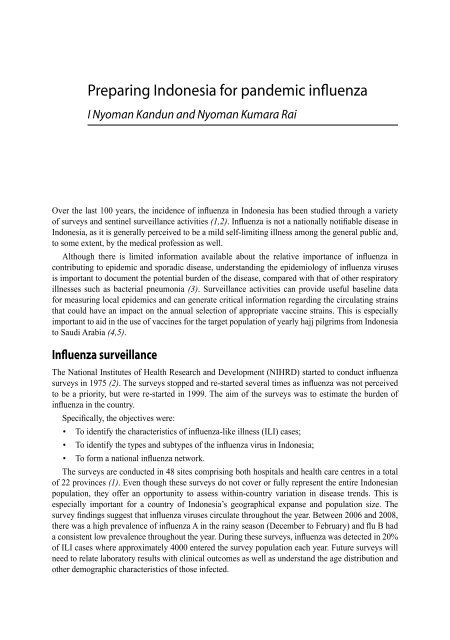South-East Asia Regional Conference on Epidemiology
South-East Asia Regional Conference on Epidemiology
South-East Asia Regional Conference on Epidemiology
Create successful ePaper yourself
Turn your PDF publications into a flip-book with our unique Google optimized e-Paper software.
Preparing Ind<strong>on</strong>esia for pandemic influenza<br />
I Nyoman Kandun and Nyoman Kumara Rai<br />
Over the last 100 years, the incidence of influenza in Ind<strong>on</strong>esia has been studied through a variety<br />
of surveys and sentinel surveillance activities (1,2). Influenza is not a nati<strong>on</strong>ally notifiable disease in<br />
Ind<strong>on</strong>esia, as it is generally perceived to be a mild self-limiting illness am<strong>on</strong>g the general public and,<br />
to some extent, by the medical professi<strong>on</strong> as well.<br />
Although there is limited informati<strong>on</strong> available about the relative importance of influenza in<br />
c<strong>on</strong>tributing to epidemic and sporadic disease, understanding the epidemiology of influenza viruses<br />
is important to document the potential burden of the disease, compared with that of other respiratory<br />
illnesses such as bacterial pneum<strong>on</strong>ia (3). Surveillance activities can provide useful baseline data<br />
for measuring local epidemics and can generate critical informati<strong>on</strong> regarding the circulating strains<br />
that could have an impact <strong>on</strong> the annual selecti<strong>on</strong> of appropriate vaccine strains. This is especially<br />
important to aid in the use of vaccines for the target populati<strong>on</strong> of yearly hajj pilgrims from Ind<strong>on</strong>esia<br />
to Saudi Arabia (4,5).<br />
Influenza surveillance<br />
The Nati<strong>on</strong>al Institutes of Health Research and Development (NIHRD) started to c<strong>on</strong>duct influenza<br />
surveys in 1975 (2). The surveys stopped and re-started several times as influenza was not perceived<br />
to be a priority, but were re-started in 1999. The aim of the surveys was to estimate the burden of<br />
influenza in the country.<br />
Specifically, the objectives were:<br />
• To identify the characteristics of influenza-like illness (ILI) cases;<br />
• To identify the types and subtypes of the influenza virus in Ind<strong>on</strong>esia;<br />
• To form a nati<strong>on</strong>al influenza network.<br />
The surveys are c<strong>on</strong>ducted in 48 sites comprising both hospitals and health care centres in a total<br />
of 22 provinces (1). Even though these surveys do not cover or fully represent the entire Ind<strong>on</strong>esian<br />
populati<strong>on</strong>, they offer an opportunity to assess within-country variati<strong>on</strong> in disease trends. This is<br />
especially important for a country of Ind<strong>on</strong>esia’s geographical expanse and populati<strong>on</strong> size. The<br />
survey findings suggest that influenza viruses circulate throughout the year. Between 2006 and 2008,<br />
there was a high prevalence of influenza A in the rainy seas<strong>on</strong> (December to February) and flu B had<br />
a c<strong>on</strong>sistent low prevalence throughout the year. During these surveys, influenza was detected in 20%<br />
of ILI cases where approximately 4000 entered the survey populati<strong>on</strong> each year. Future surveys will<br />
need to relate laboratory results with clinical outcomes as well as understand the age distributi<strong>on</strong> and<br />
other demographic characteristics of those infected.









